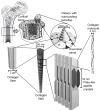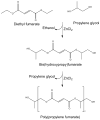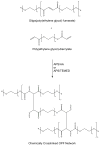Building bridges: leveraging interdisciplinary collaborations in the development of biomaterials to meet clinical needs
- PMID: 22821772
- PMCID: PMC3706713
- DOI: 10.1002/adma.201201762
Building bridges: leveraging interdisciplinary collaborations in the development of biomaterials to meet clinical needs
Abstract
Our laboratory at Rice University has forged numerous collaborations with clinicians and basic scientists over the years to advance the development of novel biomaterials and the modification of existing materials to meet clinical needs. This review highlights collaborative advances in biomaterials research from our laboratory in the areas of scaffold development, drug delivery, and gene therapy, especially as related to applications in bone and cartilage tissue engineering.
Copyright © 2012 WILEY-VCH Verlag GmbH & Co. KGaA, Weinheim.
Figures














Similar articles
-
Alginate based hybrid copolymer hydrogels--influence of pore morphology on cell-material interaction.Carbohydr Polym. 2014 Nov 4;112:235-44. doi: 10.1016/j.carbpol.2014.05.083. Epub 2014 Jun 6. Carbohydr Polym. 2014. PMID: 25129740
-
Biomaterials to gene delivery.J Control Release. 2011 Oct 30;155(2):116-8. doi: 10.1016/j.jconrel.2011.03.023. Epub 2011 Mar 30. J Control Release. 2011. PMID: 21457735 Free PMC article.
-
Bioresorbable and nonresorbable polymers for bone tissue engineering.Curr Pharm Des. 2012;18(18):2536-57. doi: 10.2174/138161212800492868. Curr Pharm Des. 2012. PMID: 22512444 Review.
-
Surface characteristics of biomaterials used for space maintenance in a mandibular defect: a pilot animal study.J Oral Maxillofac Surg. 2011 Jan;69(1):11-8. doi: 10.1016/j.joms.2010.02.026. Epub 2010 Nov 4. J Oral Maxillofac Surg. 2011. PMID: 21055856
-
Polyrotaxanes for applications in life science and biotechnology.Appl Microbiol Biotechnol. 2011 Apr;90(2):427-43. doi: 10.1007/s00253-010-3037-x. Epub 2011 Mar 1. Appl Microbiol Biotechnol. 2011. PMID: 21360153 Review.
Cited by
-
Modern Approaches to Acellular Therapy in Bone and Dental Regeneration.Int J Mol Sci. 2021 Dec 15;22(24):13454. doi: 10.3390/ijms222413454. Int J Mol Sci. 2021. PMID: 34948251 Free PMC article. Review.
-
An elastin-like recombinamer-based bioactive hydrogel embedded with mesenchymal stromal cells as an injectable scaffold for osteochondral repair.Regen Biomater. 2019 Dec;6(6):335-347. doi: 10.1093/rb/rbz023. Epub 2019 May 20. Regen Biomater. 2019. PMID: 31827887 Free PMC article.
-
Open-source three-dimensional printing of biodegradable polymer scaffolds for tissue engineering.J Biomed Mater Res A. 2014 Dec;102(12):4326-35. doi: 10.1002/jbm.a.35108. J Biomed Mater Res A. 2014. PMID: 25493313 Free PMC article.
-
Role of Tissue Engineering in COVID-19 and Future Viral Outbreaks.Tissue Eng Part A. 2020 May;26(9-10):468-474. doi: 10.1089/ten.TEA.2020.0094. Epub 2020 Apr 15. Tissue Eng Part A. 2020. PMID: 32272857 Free PMC article.
-
3D fibre deposition and stereolithography techniques for the design of multifunctional nanocomposite magnetic scaffolds.J Mater Sci Mater Med. 2015 Oct;26(10):250. doi: 10.1007/s10856-015-5582-4. Epub 2015 Sep 29. J Mater Sci Mater Med. 2015. PMID: 26420041
References
-
- Myeroff C, Archdeacon M. J Bone Joint Surg Am. 2011;93:2227. - PubMed
-
- Sawin PD, Traynelis VC, Menezes aH. J Neurosurg. 1998;88:255. - PubMed
-
- Laurencin C, Khan Y, El-Amin SF. Expert Rev Med Devices. 2006;3:49. - PubMed
-
- Greenwald aS, Boden SD, Goldberg VM, Khan Y, Laurencin CT, Rosier RN. J Bone Joint Surg Am. 2001;83-A(Suppl):98. - PubMed
-
- Polak JM, Bishop AE. Ann N Y Acad Sci. 2006;1068:352. - PubMed
Publication types
MeSH terms
Substances
Grants and funding
LinkOut - more resources
Full Text Sources

